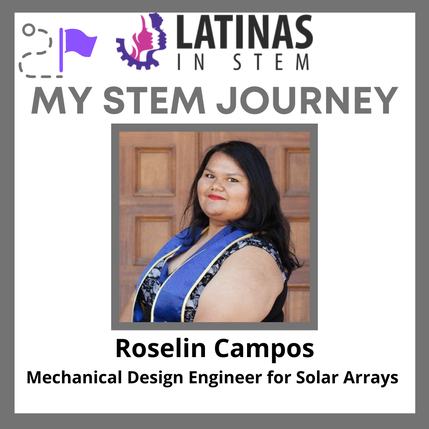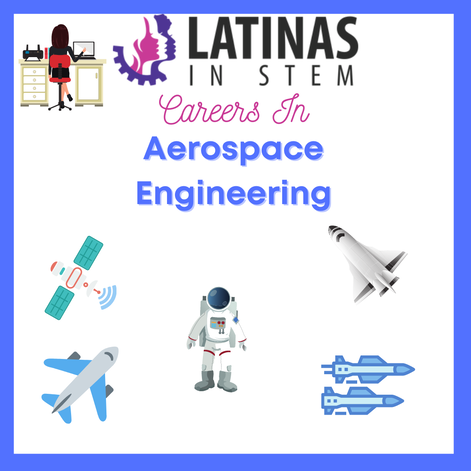I grew up in South Central Los Angeles. My parents immigrated from El Salvador with no money, searching for a better life in the U.S. They met in Los Angeles and decided to start a family. So that made me first generation for, well, everything. Since my parents did not come from wealth, they always told me that as an inheritance, they couldn’t offer me any riches or property but what they could offer me was an education. They always pushed the importance of school and going to college because they believed it was the only way I could have a better life financially than they did. My dad worked as a security guard and my mom was a stay at home mom with many side hustles (cooking Salvadoran cuisine for events, cleaning houses, working in thrift shops etc.). On my dad’s day off he would often take me to the library because he wanted to cement a love for books. At that library in Compton, was the first clue, the very first seed planted for my future career as an Aerospace Engineer.
I always gravitated toward the section full of science books that specifically covered celestial bodies. The titles were Saturn, The Moon, Comets & Asteroids, Jupiter etc. I was hooked. Every chance I got, I chose to do school reports on space and it’s celestial bodies, but I was never told or encouraged to pursue science in elementary or middle school. In fact, I didn’t know what an engineer was until I was 16 years old.
I was an incoming senior getting ready to submit my college applications. That summer, I attended the UCLA SMARTS (Science and Mathematics Achievement and Research Training for Students) program. SMARTS was a program to get students interested in STEM. I took a Statistics and a Robotics class for college credit through the program. It was my first exposure to coding, building and making something with my own hands. I was hooked, we built tiny robots using breadboards and I wrote my first computer program that summer.
I was riding the robotics course high, so I searched for the Robotics Club when I went back to school that fall. I joined Team 1692, the Crenshaw Cougarbots and participated in my first FRC (First Robotics Competition). There, I met two of the earliest influences on my decision to pursue a STEM career. Mr. Reyes was the robotics club facilitator & the school’s only computer science teacher. Tim was an actual engineer from The Aerospace Corporation who volunteered his time to mentor our Robotics team for FRC.
I took on a design role within the team, I spent most of my time drawing on the white boards thinking about what mechanisms we could put on the robot to make it accomplish certain tasks. I spent so much time at the Robotics Club that fall semester, I often brought my college applications so I could work on them. One afternoon, I was debating out loud what major to mark on my college applications. Mr. Reyes took one look at my scribbles on the whiteboard and said “You’re always around here talking about space, why don’t you apply for aerospace engineering?” I looked at him stunned. What the heck was aerospace engineering? I had never heard of it. He went on to explain that engineering was basically what I was doing in the robotics club and aerospace engineering meant I could do the same thing but what I built would either fly or go to space. I could not believe what I just learned. I quickly switched all of my major selections to aerospace engineering wherever it was available. I received my acceptance to UCLA for aerospace engineering that Spring, I had made it. I was off to pursue my dream of building things that would someday work in space.
I was 100% not prepared for what UCLA had in store for me. It’s no secret that engineering is hard, but the UCLA engineering program was on another level. I struggled quite a bit during my time there, all of my friends who were first generation students in STEM did. We weren’t prepared, there was definitely a gap in our basic math and physics education but we kept going because we knew we deserved to be there and we would just have to work a bit harder. While at UCLA, I was part of the Center for Excellence in Engineering & Diversity. I made lifelong friends there. CEED was an essential support system to get me through engineering. I met other engineering students of color from backgrounds like mine and it made me feel less alone in engineering. It was BECAUSE of CEED that I found my next leap opportunity to take a leap forward into my dream career. One of my friends had just finished an internship at Intel, in one of the group chats she joined, there was someone encouraging people to apply to The Brooke Owens Fellowship. She sent me a link to the program and application because I was the only Aerospace Engineering major she knew (she was an electrical engineering major, shout out to Justine!). As a rising senior in college, I decided to apply.
The Brooke Owens Fellowship is an aerospace fellowship that aims to increase the number of gender minorities in the aerospace industry. The fellowship offers a 10 week internship at many startups and big aerospace companies, a summit in DC to meet with the founders and other fellows, and access to a network of professionals in the industry ranging from scientists to engineers to space policy experts. The Brooke Owens fellowship was life-changing. I had the privilege to become part of the inaugural class. I had never met so many women my age, so passionate about aviation and space. Even in my classes at UCLA, I was often 1 of 3 women in a class of 60 and almost always the only person of color. Now, I suddenly knew 40+ young women just as excited about aerospace as I was.
It was through becoming a fellow that I landed an internship with Space Systems Loral (now Maxar Technologies Space Division). Maxar is a satellite manufacturer located in Silicon Valley. We make satellites for space exploration, imaging and GEO applications. I now work full time for MAXAR as a Mechanical Design Engineer for Solar Arrays. I’ve learned SO much in the past three years about space hardware, the industry, what it takes to take a design from concept to test and finally to flight. I am currently working on qualifying (testing phase of a new design) a solar array wing and it is expected to launch later this year!
My journey to become an Aerospace Engineer wasn’t easy, it wasn’t linear, it was hard, frustrating and sometimes lonely but it was also fun, exciting and inspiring. I want to help other first generation students realize that they have the option to go into a career in aerospace. I want everyone to know that aerospace now, more than ever before, is for everyone.



 RSS Feed
RSS Feed

